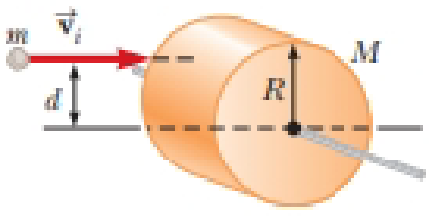
Concept explainers
A wad of sticky clay with mass m and velocity
Figure P11.29

Trending nowThis is a popular solution!

Chapter 11 Solutions
Physics for Scientists and Engineers with Modern Physics
- A buzzard (m = 9.29 kg) is flying in circular motion with aspeed of 8.44 m/s while viewing its meal below. If the radius ofthe buzzards circular motion is 8.00 m, what is the angularmomentum of the buzzardaround the center of its motion?arrow_forwardA solid cylinder of mass 2.0 kg and radius 20 cm is rotating counterclockwise around a vertical axis through its center at 600 rev/min. A second solid cylinder of the same mass and radius is rotating clockwise around the same vertical axis at 900 rev/min. If the cylinders couple so that they rotate about the same vertical axis, what is the angular velocity of the combination?arrow_forwardA wad of sticky clay with mass m and velocity vi is fired at a solid cylinder of mass M and radius R (Fig. P10.75). The cylinder is initially at rest and is mounted on a fixed horizontal axle that runs through its center of mass. The line of motion of the projectile is perpendicular to the axle and at a distance d R from the center. (a) Find the angular speed of the system just after the clay strikes and sticks to the surface of the cylinder. (b) Is the mechanical energy of the claycylinder system constant in this process? Explain your answer. (c) Is the momentum of the claycylinder system constant in this process? Explain your answer. Figure P10.75arrow_forward
- Two astronauts (Fig. P10.67), each having a mass M, are connected by a rope of length d having negligible mass. They are isolated in space, orbiting their center of mass at speeds v. Treating the astronauts as particles, calculate (a) the magnitude of the angular momentum of the two-astronaut system and (b) the rotational energy of the system. By pulling on the rope, one of the astronauts shortens the distance between them to d/2. (c) What is the new angular momentum of the system? (d) What are the astronauts new speeds? (e) What is the new rotational energy of the system? (f) How much chemical potential energy in the body of the astronaut was converted to mechanical energy in the system when he shortened the rope? Figure P10.67 Problems 67 and 68.arrow_forwardA thin rod of length 2.65 m and mass 13.7 kg is rotated at anangular speed of 3.89 rad/s around an axis perpendicular to therod and through its center of mass. Find the magnitude of therods angular momentum.arrow_forwardA uniform disk of mass m = 10.0 kg and radius r = 34.0 cm mounted on a frictionlessaxle through its center, and initially at rest, isacted upon by two tangential forces of equalmagnitude F, acting on opposite sides of itsrim until a point on the rim experiences acentripetal acceleration of 4.00 m/s2 (Fig.P13.73). a. What is the angular momentumof the disk at this time? b. If F = 2.00 N, howlong do the forces have to be applied to thedisk to achieve this centripetal acceleration? FIGURE P13.73arrow_forward
- A thin rod of length 2.65 m and mass 13.7 kg is rotated at anangular speed of 3.89 rad/s around an axis perpendicular to therod and through one of its ends. Find the magnitude of the rodsangular momentum.arrow_forwardThe velocity of a particle of mass m = 2.00 kg is given by v= 5.10 + 2.40 m /s. What is the angular momentumof the particle around the origin when it is located atr= 8.60 3.70 m?arrow_forwardThe position vector of a particle of mass 2.00 kg as a function of time is given by r=(6.00i+5.00tj), where r is in meters and t is in seconds. Determine the angular momentum of the particle about the origin as a function of time.arrow_forward
- A wheel 2.00 m in diameter lies in a vertical plane and rotates about its central axis with a constant angular acceleration of 4.00 rad/s2. The wheel starts at rest at t = 0, and the radius vector of a certain point P on the rim makes an angle of 57.3 with the horizontal at this time. At t = 2.00 s, find (a) the angular speed of the wheel and, for point P, (b) the tangential speed, (c) the total acceleration, and (d) the angular position.arrow_forwardA system consists of a disk of mass 2.0 kg and radius 50 cm upon which is mounted an annular cylinder of mass 1.0 kg with inner radius 20 cm and outer radius 30 cm (see below). The system rotates about an axis through the center of the disk and annular cylinder at 10 rev/s. (a) What is the moment of inertia of the system? (b) What is its rotational kinetic energy?arrow_forwardA uniform rod of length b stands vertically upright on a rough floor and then tips over. What is the rods angular velocity when it hits the floor?arrow_forward
 Principles of Physics: A Calculus-Based TextPhysicsISBN:9781133104261Author:Raymond A. Serway, John W. JewettPublisher:Cengage Learning
Principles of Physics: A Calculus-Based TextPhysicsISBN:9781133104261Author:Raymond A. Serway, John W. JewettPublisher:Cengage Learning Physics for Scientists and EngineersPhysicsISBN:9781337553278Author:Raymond A. Serway, John W. JewettPublisher:Cengage Learning
Physics for Scientists and EngineersPhysicsISBN:9781337553278Author:Raymond A. Serway, John W. JewettPublisher:Cengage Learning Physics for Scientists and Engineers with Modern ...PhysicsISBN:9781337553292Author:Raymond A. Serway, John W. JewettPublisher:Cengage Learning
Physics for Scientists and Engineers with Modern ...PhysicsISBN:9781337553292Author:Raymond A. Serway, John W. JewettPublisher:Cengage Learning University Physics Volume 1PhysicsISBN:9781938168277Author:William Moebs, Samuel J. Ling, Jeff SannyPublisher:OpenStax - Rice University
University Physics Volume 1PhysicsISBN:9781938168277Author:William Moebs, Samuel J. Ling, Jeff SannyPublisher:OpenStax - Rice University Physics for Scientists and Engineers: Foundations...PhysicsISBN:9781133939146Author:Katz, Debora M.Publisher:Cengage Learning
Physics for Scientists and Engineers: Foundations...PhysicsISBN:9781133939146Author:Katz, Debora M.Publisher:Cengage Learning Glencoe Physics: Principles and Problems, Student...PhysicsISBN:9780078807213Author:Paul W. ZitzewitzPublisher:Glencoe/McGraw-Hill
Glencoe Physics: Principles and Problems, Student...PhysicsISBN:9780078807213Author:Paul W. ZitzewitzPublisher:Glencoe/McGraw-Hill





